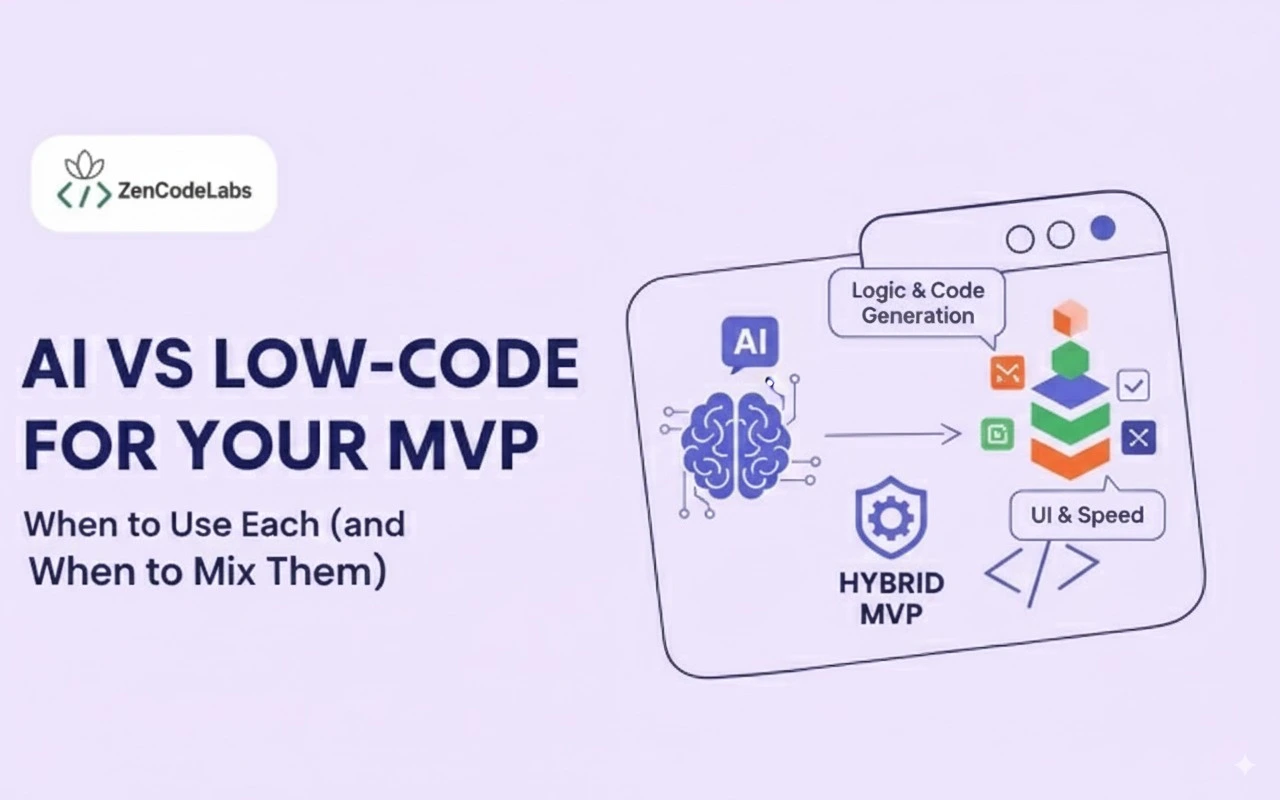AI vs Low-Code in MVP Development
Should you build your MVP with AI-generated code, a low-code platform, or a hybrid approach? A researched, practical guide for founders and technical leads.

Table of Contents
- Why This Choice Matters
- Clear Definitions
- Evidence & Industry Trends
- Pros & Cons at a Glance
- A Practical Decision Flow
- Implementing a Hybrid Workflow
- Risks & Mitigation
- Tools & Patterns (2025 Snapshot)
- Bottom Line — Decision Checklist
- Further Reading
Why This Choice Matters
Choosing how to build your MVP affects speed, cost, technical risk, and your ability to iterate after product–market fit. In 2025, founders can choose traditional hand-coding, low-code platforms, AI-assisted coding, or a hybrid of these approaches. Each has strengths and pitfalls—the key is picking the path that reduces your riskiest unknowns fastest.
Clear Definitions
- Low-Code: Visual editors and prebuilt components that minimize manual coding. Best for UI-heavy apps and workflow-driven products. Modern platforms like FlutterFlow also allow code export and custom Dart extensions.
- AI-Assisted Development: Generative coding tools (e.g., GitHub Copilot, Replit AI, ChatGPT in IDEs) that scaffold, refactor, or test code from natural language prompts. Still requires review by developers.
- Hybrid Approach: Use low-code for common UX (onboarding, dashboards) and AI to generate business logic, API adapters, validators, or tests. Provides speed without sacrificing long-term ownership.
Evidence & Industry Trends
- Studies on AI coding assistants (GitHub, Stack Overflow surveys) show productivity gains up to 30–40%, but outputs vary by complexity and require guardrails.
- Security audits in 2024 revealed higher vulnerability rates in unreviewed AI-generated code, underscoring the need for human validation.
- Enterprises continue to scale with low-code for internal tools and governed workflows, but customization ceilings and vendor lock-in remain concerns.
- For AI-native MVPs (chatbots, recommendation engines, generative apps), the model and dataset become the product. Data quality matters more than speed of UI assembly.
Pros & Cons at a Glance
Low-Code
Pros:
- Fastest for UI + workflows.
- Non-developers can contribute.
- Many platforms bundle auth, DB, payments. Cons:
- Customization limits.
- Vendor lock-in risks.
- Performance/observability trade-offs.
AI-Assisted Coding
Pros:
- Flexible scaffolding of components, APIs, and tests.
- Full ownership of source code.
- Speeds up small engineering teams. Cons:
- Variable quality.
- Security vulnerabilities if unchecked.
- Steeper learning curve for non-technical founders.
Hybrid
- Best of both worlds: rapid low-code UI + AI glue code + early code export.
A Practical Decision Flow
- Is your riskiest assumption market or technical?
- Market → go low-code for speed and demos.
- Technical → use AI-assisted or custom code prototypes to prove feasibility.
- Team skills:
- Non-technical founders → start in low-code.
- Small dev team → use AI scaffolding + manual polish.
- Does AI/ML define your product?
- If yes → focus first on data pipeline + model prototyping, then wrap in low-code UI.
Implementing a Hybrid Workflow
- Set boundaries: Which flows stay in low-code? Which will migrate to custom code?
- Use AI for repeatables: API scaffolds, validators, unit tests, mock data.
- Automate QA: Linting, dependency checks, and static analysis to catch weak AI code.
- Export early: Keep low-code exports in version control; run CI/CD against them.
- Instrument prototypes: Track events, errors, and performance for faster iteration.
Example: Build onboarding in FlutterFlow. Export code. Use AI to generate validators + unit tests. Run in GitHub Actions CI. Fix failures. Iterate.
Risks & Mitigation
- Security leaks: Don’t paste secrets into AI prompts. Run secret scanning.
- Tech debt from AI churn: Pair AI-generated code with architecture reviews.
- Vendor lock-in: Favor platforms with code export (FlutterFlow) or modular architecture.
Tools & Patterns (2025 Snapshot)
- Low-Code: FlutterFlow (mobile + code export), OutSystems, Mendix, AppSheet.
- AI Assistants: GitHub Copilot, ChatGPT for IDEs, Replit Ghostwriter.
- CI/CD + QA: Fastlane, Codemagic, GitHub Actions integrated with AI output review.
- AI MVP Playbooks: Lean model prototyping frameworks for LLM- or ML-driven features.
Bottom Line — Decision Checklist
- If you need to validate user demand fast → start with low-code.
- If ownership and flexibility matter → lean on AI-assisted coding with strong review.
- If you want both → choose a hybrid: low-code UI + AI-generated logic + CI validation.
Further Reading
- GitHub Copilot productivity studies
- OWASP guidance on AI code security
- FlutterFlow documentation
- Gartner Low-Code Platforms report
- Best practices for AI MVPs
Takeaway: Startups don’t need to pick sides. Use low-code to accelerate, AI to extend, and always keep an exportable, testable code path.
